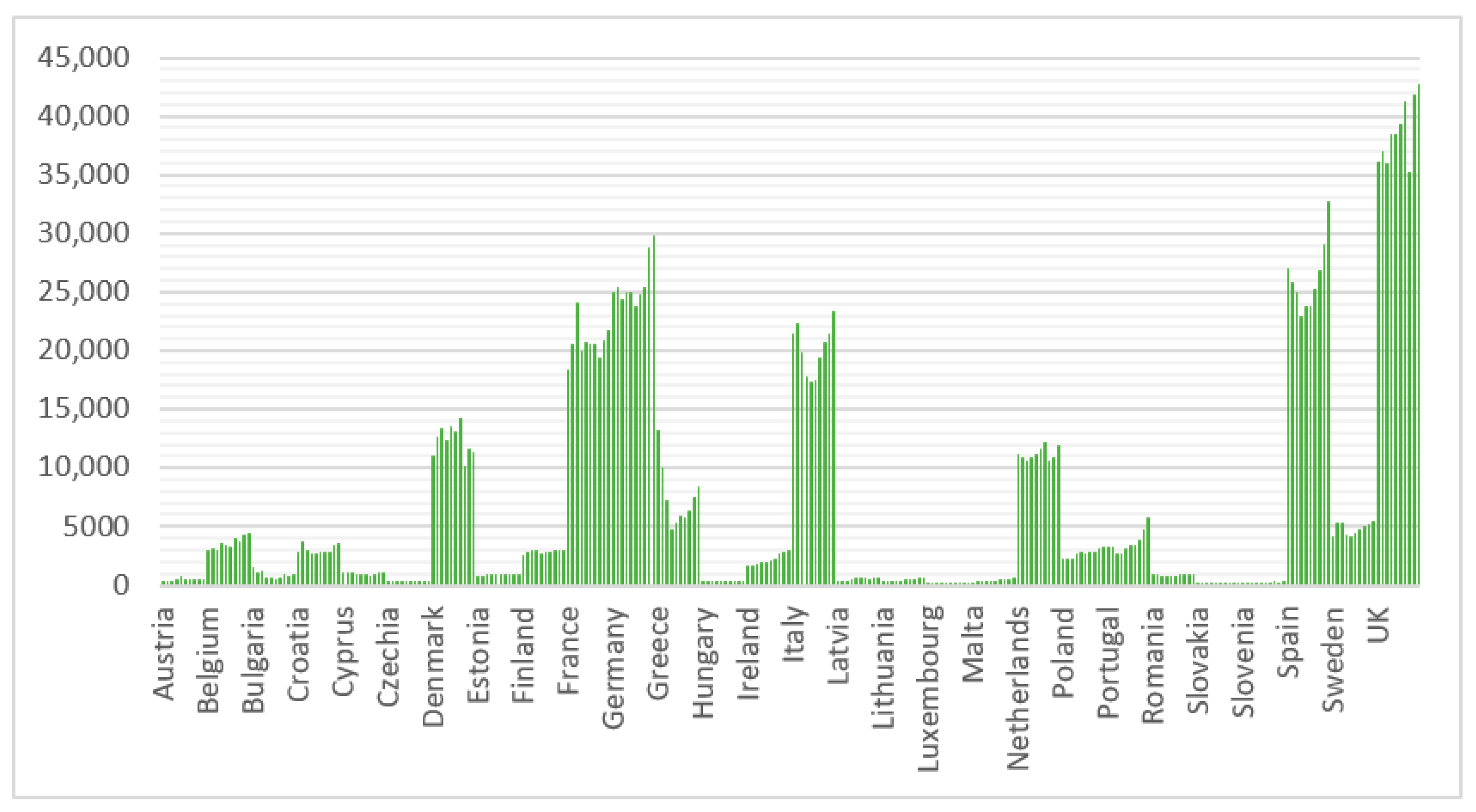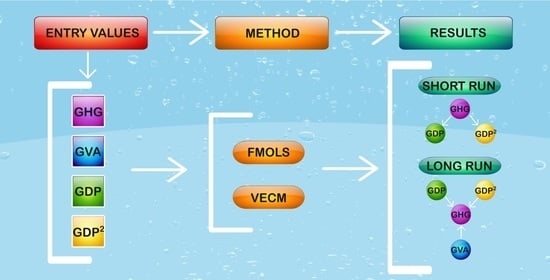Connecting Blue Economy and Economic Growth to Climate Change: Evidence from European Union Countries
Abstract
:1. Introduction
2. Literature Review
3. Materials and Methods
3.1. Data Analysis
3.2. Research Methodology
- The identification and the direction of the causality relation among the variables included in the model;
- An analysis of the Blue Economy’s influence on the performance of the environment;
- Positioning these EU-28 countries from the point of view of the influence of the economic growth on the degradation of the environment according to the EKC [32].
4. Results
5. Discussions
6. Conclusions
Author Contributions
Funding
Institutional Review Board Statement
Informed Consent Statement
Data Availability Statement
Conflicts of Interest
References
- UNEP. Annual Report. 2016. Available online: www.unenvironment.org/annualreport/2015/en/index.html (accessed on 1 May 2021).
- OECD. The Ocean. Economy in 2030; OECD Publishing: Paris, France, 2016; Available online: www.oecd-ilibrary.org/economics/the-ocean-economyin-2030_9789264251724-en (accessed on 25 April 2021).
- WWF. Principles for a Sustainable Blue Economy. 2018. Available online: https://wwfeu.awsassets.panda.org/downloads/wwf_marine_briefing_principles_blue_economy.pdf (accessed on 5 April 2021).
- Keen, M.R.; Schwarz, A.M.; Wini-Simeon, L. Towards defining the Blue Economy: Practical lessons from Pacific Ocean governance. Mar. Policy 2017, 88, 333–341. [Google Scholar] [CrossRef]
- UNEP. Blue Economy: Sharing Success Stories to Inspire Change. 2015. Available online: www.unep.org/greeneconomy (accessed on 13 May 2021).
- European Commission. Communication from the Commission to the European Parliament, the Council, the European Economic and Social Committee and the Committee of the Regions Initiative for the Sustainable Development of the Blue Economy in the Western Mediterranean. 2017. Available online: https://ec.europa.eu/regional_policy/sources/docoffic/2014/com_2017_376_2_en.pdf (accessed on 14 March 2021).
- European Commission. Proposal for a Directive of the European Parliament and of the Council Establishing a Framework for Maritime Spatial Planning and Integrated Coastal Management. 2013. Available online: https://ec.europa.eu/environment/iczm/pdf/Proposal_en.pdf (accessed on 3 May 2021).
- Patil, P.G.; Virdin, J.; Diez, S.M.; Roberts, J.; Singh, A. Toward a Blue Economy: A Promise for Sustainable Growth in the Caribbean; An Overview; The World Bank: Washington, DC, USA, 2016. [Google Scholar]
- Hall, P.O.J.; Anderson, L.G.; Holby, O.; Kollberg, S.; Samuelsson, M.O. Chemical fluxes and mass balances in a marine fish cage farm. I. Carbon. Mar. Ecol. Prog. Ser. 1990, 61, 61–73. [Google Scholar] [CrossRef]
- Porello, S.; Lenzi, M.; Persia, E.; Tomassetti, P.; Finoia, M.G. Reduction of aquaculture wastewater eutrophication by phytotreatment ponds system I. Dissolved and particulate nitrogen and phosphorus. Aquaculture 2003, 219, 515–529. [Google Scholar] [CrossRef]
- Robb, D.H.F.; MacLeod, M.; Hasan, M.R.; Soto, D. Greenhouse Gas. Emissions from Aquaculture: A Life Cycle Assessment of Three Asian Systems; FAO Fisheries and Aquaculture Technical Paper No. 609; Food And Agriculture Organization of the United Nations: Rome, Italy, 2017; ISBN 978-92-5-109833-2. [Google Scholar]
- Hoegh-Guldberg, O.; Caldeira, K.; Chopin, T.; Gaines, S.; Haugan, P.; Hemer, M.; Howard, J.; Konar, M.; Krause-Jensen, D.; Lovelock, C.; et al. The Ocean as a Solution to Climate Change: Five Opportunities for Action; Report; World Resources Institute: Washington, DC, USA, 2019; Available online: https://oceanpanel.org/sites/default/files/2019-10/HLP_Report_Ocean_Solution_Climate_Change_final.pdf (accessed on 13 April 2021).
- United Nations Environment Programme. Greenhouse Gases Are Depriving Our Oceans of Oxygen. 2019. Available online: www.unenvironment.org/news-and-stories/story/greenhouse-gases-are-depriving-our-oceans-oxygen (accessed on 16 June 2021).
- Rogelj, J.; Elzen, M.D.; Höhne, N.; Fransen, T.; Fekete, H.; Winkler, H.; Schaeffer, R.; Sha, F.; Riahi, K.; Meinshausen, M. Paris Agreement climate proposals need a boost to keep warming well below 2 °C. Nat. Cell Biol. 2016, 534, 631–639. [Google Scholar] [CrossRef] [PubMed] [Green Version]
- Adams, E.E.; Caldeira, K. Ocean Storage of CO2. Elements 2008, 4, 319–324. Available online: https://people.ucsc.edu/~mdmccar/migrated/ocea213/readings/15_GeoEngineer/C_sequestration/adams_2008_Elements_CALDERIA_Ocean_CO2_Storeage.pdf (accessed on 31 March 2021). [CrossRef]
- Renforth, P.; Henderson, G. Assessing Ocean Alkalinity for Carbon Sequestration. Rev. Geophys 2017, 55, 636–674. [Google Scholar] [CrossRef]
- Widdicombe, S.; Blackford, J.C.; Spicer, J.J. Assessing the Environmental Consequences of CO2 Leakage from Geological CCS: Generating Evidence to Support Environmental Risk Assessment. Mar. Pollut. Bull. 2013, 73, 399–401. [Google Scholar] [CrossRef] [PubMed]
- Froehlich, H.E.; Afflerbach, J.C.; Frazier, M.; Halpern, B.S. Blue Growth Potential to Mitigate Climate Change through Seaweed Offsetting. Curr. Biol. 2019, 29, 3087–3093. [Google Scholar] [CrossRef] [PubMed]
- Walker, T.R.; Adebambo, O. Environmental effects of marine transportation. In World Seas: An Environmental Evaluation Volume III: Ecological Issues and Environmental Impacts, 2nd ed.; Elsevier Ltd.: Amsterdam, The Netherlands, 2018; Volume 3, pp. 505–530. [Google Scholar]
- Vidas, S.; Cukrov, M.; Sutalo, V.; Rudan, S. CO2 Emissions Reduction Measures for RO-RO Vessels on Non-Profitable Coastal Liner Passenger Transport. Sustainability 2021, 13, 6909. [Google Scholar] [CrossRef]
- European Commission. 2020 Blue Economy Report: Blue Sectors Contribute to the Recovery and Pave Way for EU Green Deal. 2020. Available online: https://ec.europa.eu/commission/presscorner/detail/en/IP_20_986 (accessed on 19 June 2021).
- European Commission. 2019 Annual Report from the European Commission on CO2 Emissions from Maritime Transport. 2020. Available online: https://ec.europa.eu/clima/sites/clima/files/transport/shipping/docs/swd_2020_82_en.pdf (accessed on 20 June 2021).
- European Parliament and Council. Regulation (EU) 2015/757 on the Monitoring, Reporting and Verification of Carbon Dioxide Emissions from Maritime Transport. 2015. Available online: https://eur-lex.europa.eu/legal-content/EN/TXT/?uri=celex%3A32015R0757 (accessed on 4 July 2021).
- Bouman, E.A.; Lindstad, E.; Rialland, A.I.; Strømman, A.H. State-of-the-Art Technologies, Measures, and Potential for Reducing GHG Emissions from Shipping: A Review. Transp. Res. Part. D 2017, 52, 408–421. [Google Scholar] [CrossRef]
- Copping, A.; Sather, N.; Hanna, L.; Whiting, J.; Zydlewski, G.; Staines, G.; Gill, A.; Hutchison, I.; O’Hagan, A.; Simas, T.; et al. Annex IV 2016 State of the Science Report: Environmental Effects of Marine Renewable Energy Development Around the World. 2016. Available online: https://tethys.pnnl.gov/publications/state-of-the-science-2016 (accessed on 20 April 2021).
- Rodriguez-Rodrigues, D.; Rodriguez, J.; Malak, D.A.; Nastasi, A.; Hernandes, P. Marine protected areas and fisheries restricted areas in the Mediterranean: Assessing "actual" marine biodiversity protection coverage at multiple scales. Mar. Policy 2016, 64, 24–30. [Google Scholar] [CrossRef]
- FAO. The State of World Fisheries and Aquaculture 2018—Meeting the Sustainable Development Goals. Rome. Licence: CC BY-NC-SA 3.0 IGO. 2018. Available online: http://www.fao.org/3/i9540en/i9540en.pdf (accessed on 20 March 2021).
- EPRS. Ocean Governance and Blue Growth Challenges, Opportunities and Policy Responses. 2019. Available online: www.europarl.europa.eu/RegData/etudes/BRIE/2019/635557/EPRS_BRI(2019)635557_EN.pdf (accessed on 15 April 2021).
- European Commission. A Sustainable Blue Growth Agenda for the Baltic Sea Region. Brussels, 16.5.2014. SWD(2014) 167 Final. 2014. Available online: https://ec.europa.eu/maritimeaffairs/sites/maritimeaffairs/files/docs/body/swd-2014-167_en.pdf.pdf (accessed on 19 June 2021).
- Roos, I.; Soosaara, S.; Volkovaa, A.; Streimikeneb, D. Greenhouse gas emissions reduction perspectives in the Baltic States in frames of EU energy and climate policy. Renew. Sustain. Energy Rev. 2012, 16, 2133–2146. [Google Scholar] [CrossRef]
- Streimikiene, D. Climate Change Mitigation Policies in Energy Sector of Baltic States. 2007. Available online: www.worldenergy.org/assets/downloads/PUB_Energy_and_Climate_Change_Annex_Baltic_states_2007_WEC.pdf (accessed on 21 April 2021).
- Kuznets, S. Economic growth and income inequality. Am. Econ. Rev. 1955, 45, 1–28. [Google Scholar]
- He, J.; Richard, P. Environmental Kuznets curve for CO2 in Canada. Ecol. Econ. 2010, 69, 1083–1093. [Google Scholar] [CrossRef] [Green Version]
- Levin, A.; Lin, C.F.; Chu, C.S.J. Unit Root Tests in Panel Data: Asymptotic and Finite-Sample Properties. J. Econom. 2002, 108, 1–24. [Google Scholar] [CrossRef]
- Pedroni, P. Critical values for cointegration tests in heterogeneous panels with multiple regressors. Oxf. Bull. Econ. Stat. 1999, 61, 653–670. [Google Scholar] [CrossRef]
- Pedroni, P. Panel cointegration: Asymptotic and finite sample properties of pooled time series tests with an application to the PPP hypothesis. Econom. Theory 2004, 20, 597–625. [Google Scholar] [CrossRef] [Green Version]
- Kao, C. Spurious regression and residual-based tests for cointegration in panel data. J. Econom. 1999, 90, 1–44. [Google Scholar] [CrossRef]
- Phillips, P.; Hansen, B. Statistical Inference in Instrumental Variables Regression with I(1) Process-es. Rev. Econ. Stud. 1990, 57, 99–125. [Google Scholar] [CrossRef]
- Engle, R.F.; Granger, C.W.J. Cointegration and Error Correction: Representation, Estimation and Testing. Econometrica 1987, 55, 251–276. [Google Scholar] [CrossRef]

| lnGHG | lnGVA | lnGDP | lnGDP2 | |
|---|---|---|---|---|
| lnGHG | 1.000000 - | |||
| lnGVA | 0.675645 (0.0000) | 1.000000 - | ||
| lnGDP | 0.143160 (0.0165) | 0.257532 (0.0000) | 1.000000 - | |
| lnGDP2 | 0.137406 (0.0215) | 0.244562 (0.0000) | 0.999312 (0.0000) | 1.000000 - |
| Method | Common Unit Root Test LLC | |
|---|---|---|
| lnGHG | Stat (p-value) | −7.7373 (0.0000) |
| dlnGHG | Stat (p-value) | −4.7787 (0.0000) |
| lnGVA | Stat (p-value) | 0.5585 (0.7118) |
| dlnGVA | Stat (p-value) | −6.9652 (0.0000) |
| lnGDP | Stat (p-value) | −0.1718 (0.4318) |
| dlnGDP | Stat (p-value) | −7.8937 (0.0000) |
| lnGDP2 | Stat (p-value) | −0.0274 (0.4891) |
| dlnGDP2 | Stat (p-value) | −7.7604 (0.0000) |
| Alternative Hypothesis: Common AR Coeff. (within-Dimension) | ||||
|---|---|---|---|---|
| Statistic | Prob. | Statistic | Prob. | |
| Panel v-Stat | −2.1319 | 0.9835 | −2.6506 | 0.9960 |
| Panel rho-Stat | 2.6744 | 0.9963 | 2.4916 | 0.9936 |
| Panel PP-Stat | −6.2131 | 0.0000 | −6.0610 | 0.0000 |
| Panel ADF-Stat | −4.9240 | 0.0000 | −4.5530 | 0.0000 |
| Alternative Hypothesis: Individual AR Coeff. (between-Dimension) | ||||
| Statistic | Prob. | |||
| Group rho-Stat | 5.1094 | 1.0000 | ||
| Group PP-Stat | −8.7019 | 0.0000 | ||
| Group ADF-Stat | −5.8470 | 0.0000 | ||
| t-Statistic | Prob. | |
|---|---|---|
| ADF | −1.646895 | 0.0498 |
| Residual variance | 0.008152 | |
| HAC variance | 0.006855 |
| Variable | Coefficient | Std. Error | t-Statistic | Prob. |
|---|---|---|---|---|
| Long Run Equation | ||||
| lnGDP | 3.0453 | 0.0187 | 162.0452 | 0.0000 |
| lnGDP2 | –0.2318 | 0.0406 | –5.6978 | 0.0000 |
| lnGVA | –0.1065 | 0.0286 | –3.7165 | 0.0003 |
| Error Correction: | d(lnGHG) | d(lnGVA) | d(lnGDP) | d(lnGDP2) |
|---|---|---|---|---|
| ECT(−1) | −0.000343 | 0.000403 | −0.000160 | −0.002435 |
| (0.00024) | (0.00035) | (6.4 × 10−5) | (0.00131) | |
| [−1.44727] | [1.15182] | [−2.48574] | [−1.86299] | |
| d(lnGHG(−1)) | −0.153350 | −0.020106 | 0.029195 | 0.574425 |
| (0.06374) | (0.09405) | (0.01726) | (0.35135) | |
| [−2.40575] | [−0.21379] | [1.69176] | [1.63492] | |
| d(lnGVA(−1)) | 0.043706 | −0.138191 | 0.016461 | 0.323563 |
| (0.04465) | (0.06588) | (0.01209) | (0.24613) | |
| [0.97878] | [−2.09753] | [1.36165] | [1.31460] | |
| d(lnGDP(−1)) | −0.341455 | 1.909622 | 1.074648 | 15.59224 |
| (3.32055) | (4.89916) | (0.89897) | (18.3027) | |
| [−0.10283] | [0.38979] | [1.19542] | [0.85191] | |
| d(lnGDP2(−1)) | 0.016601 | −0.032226 | −0.030785 | −0.321307 |
| (0.16535) | (0.24396) | (0.04476) | (0.91139) | |
| [0.10040] | [−0.13210] | [−0.68771] | [−0.35254] |
Publisher’s Note: MDPI stays neutral with regard to jurisdictional claims in published maps and institutional affiliations. |
© 2021 by the authors. Licensee MDPI, Basel, Switzerland. This article is an open access article distributed under the terms and conditions of the Creative Commons Attribution (CC BY) license (https://creativecommons.org/licenses/by/4.0/).
Share and Cite
Bădîrcea, R.M.; Manta, A.G.; Florea, N.M.; Puiu, S.; Manta, L.F.; Doran, M.D. Connecting Blue Economy and Economic Growth to Climate Change: Evidence from European Union Countries. Energies 2021, 14, 4600. https://doi.org/10.3390/en14154600
Bădîrcea RM, Manta AG, Florea NM, Puiu S, Manta LF, Doran MD. Connecting Blue Economy and Economic Growth to Climate Change: Evidence from European Union Countries. Energies. 2021; 14(15):4600. https://doi.org/10.3390/en14154600
Chicago/Turabian StyleBădîrcea, Roxana Maria, Alina Georgiana Manta, Nicoleta Mihaela Florea, Silvia Puiu, Liviu Florin Manta, and Marius Dalian Doran. 2021. "Connecting Blue Economy and Economic Growth to Climate Change: Evidence from European Union Countries" Energies 14, no. 15: 4600. https://doi.org/10.3390/en14154600
APA StyleBădîrcea, R. M., Manta, A. G., Florea, N. M., Puiu, S., Manta, L. F., & Doran, M. D. (2021). Connecting Blue Economy and Economic Growth to Climate Change: Evidence from European Union Countries. Energies, 14(15), 4600. https://doi.org/10.3390/en14154600










